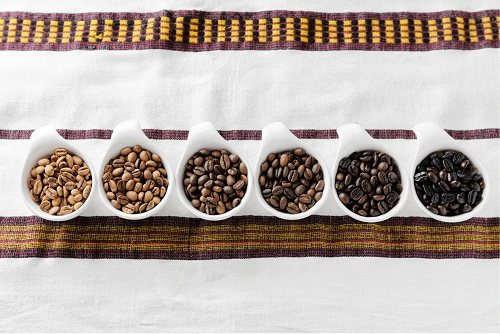Coffee
Learn Coffee Roasting Process
The coffee roasting process involves the transformation of green coffee beans into roasted coffee beans with the desired flavors, aromas, and characteristics. The journey starts with the green bean and ends up as the perfect beverage entirely made to your liking. Whether you like your coffee as a dripped, filtered, cold brew, espresso, or any other possibility, they all have one thing in common; it all starts with the green bean.
Coffee, the beloved beverage that fuels millions of people around the world, undergoes a remarkable transformation before it reaches your cup. From the moment it starts as a green bean, the coffee roasting process is a journey that brings out the desired flavors, aromas, and characteristics. In this article, we will take you through the captivating journey of coffee roasting, from the selection of beans to the cooling and packaging process.
Green Coffee Composition
Green coffee beans contain numerous compounds, including carbohydrates, proteins, lipids, acids, and chlorogenic acids. These compounds interact and undergo transformations during roasting, influencing the flavor profile of the final product.
Green Coffee Beans Selection
The process of coffee roasting starts with the careful selection of high-quality green coffee beans. Roasters consider factors like the origin, variety, and desired flavor profiles to ensure the best possible taste in the final product. This step lays the foundation for the entire roasting process.
Preheating the Roasting Machine
Before the roasting begins, the roaster preheats the roasting machine to the appropriate temperature, typically ranging from 180°C to 220°C (356°F to 428°F). The right temperature is crucial to achieving the desired roast level.
Charging the Roasting Drum
Once the machine is preheated, the roaster charges the roasting drum or chamber with the selected green coffee beans. The beans are ready to undergo their transformation.
Drying Phase or Moisture Evaporation
The roasting process commences with the drying phase, during which the beans lose moisture and turn yellow. This phase usually lasts a few minutes and sets the stage for the subsequent changes.
At the beginning of the roasting process, the beans’ moisture content is high, typically around 8-12%. As the temperature rises, moisture starts evaporating from the beans. This process is known as “drying” or the “endothermic phase.” Drying is crucial because it prepares the beans for subsequent chemical reactions.
Maillard Reaction
The Maillard reaction is a key chemical reaction that occurs during roasting. It is the interaction between amino acids and reducing sugars in the beans, resulting in the formation of new flavor compounds. These compounds produce the rich flavors and brown color associated with roasted coffee.
The Maillard reaction progresses rapidly as the temperature rises, leading to the development of a wide range of flavor compounds, including caramel, chocolate, and nutty notes.
First Crack and Development Stage
As the roasting process progresses, the beans experience the first crack. This distinctive popping sound occurs when moisture inside the beans expands, causing them to crack open. The beans also start to increase in size and release carbon dioxide. Different roast levels are achieved based on when the first crack is halted.
As the roasting temperature reaches a critical point, typically around 385-405°F (196-207°C), the beans undergo the “first crack.” During this stage, the pressure inside the beans builds up, causing them to expand and crack audibly. This marks the transition from light to medium roast levels.
The duration of the development stage after the first crack significantly impacts the coffee’s acidity and sweetness. Longer development times tend to produce darker roasts with reduced acidity but enhanced sweetness and body.
The coffee beans enter the development phase. This critical step is where the flavors and aromas intensify. The roaster skillfully adjusts the temperature and time to attain the desired roast level, be it light, medium, or dark roast.
Acidity and Caramelization
Acidity in coffee is desirable and contributes to its brightness and liveliness. During roasting, some of the acids present in green coffee beans break down or undergo transformations. The higher the roasting temperature and the longer the duration, the more the acidity diminishes.
Simultaneously, caramelization occurs, leading to the formation of caramel-like, sweet flavors. Balanced roasting can maintain a pleasant level of acidity while promoting sweetness through caramelization.
Second Crack and Dark Roasts(Optional)
For those seeking darker roasts, a second crack may occur. The second crack is louder and more intense than the first and leads to the creation of darker and oilier beans, often used in espresso roasts.
In darker roast levels, around 435-455°F (224-235°C), the beans may undergo a “second crack.” This crackling sound indicates further expansion and carbonization of the beans.
Darker roasts exhibit reduced acidity and more pronounced bitter, smoky, or charred flavors due to prolonged exposure to high temperatures.
Cooling the Roasted Beans
After reaching the desired roast level, rapid cooling of the beans is essential to stop the roasting process. Proper cooling helps “lock in” the desired flavors and prevents over-roasting.
Resting and Degassing
After roasting, the beans need some time to rest and degas. Roasters typically allow the beans to rest for 12 to 24 hours or longer. During this resting phase, the beans release carbon dioxide, which can affect the taste if not given sufficient time.
Packaging the Roasted Beans
Finally, the roaster packages the freshly roasted beans in airtight bags or containers to maintain their freshness and flavor. Some roasters offer whole bean coffee, while others grind the beans before packaging.
Summary
The coffee roasting process is an art and a science combined. Roasters experiment with different roast profiles and techniques to bring out specific flavors and characteristics from various coffee beans. Each roast level, whether light, medium, or dark, imparts unique flavors and nuances to the coffee, providing a diverse range of taste experiences for coffee enthusiasts.
The journey from green coffee beans to the perfect cup of coffee is an intricate process that requires skill, precision, and an understanding of the desired flavor profiles. Whether you prefer a light, medium, or dark roast, each variation brings a unique and delightful experience to the discerning palate. So, the next time you savor your favorite brew, take a moment to appreciate the artistry behind the coffee roasting process that enhances the simple coffee bean into a beverage cherished worldwide.
FAQs
1. Does the origin of the coffee beans affect the roasting process? Absolutely! The origin plays a significant role in determining the coffee’s flavor profile and how it should be roasted to bring out the best taste.
2. Can I roast coffee beans at home? Yes, you can roast coffee beans at home using various methods, such as using a stovetop popcorn popper or a dedicated home coffee roaster.
3. What is the best way to store roasted coffee beans? To maintain freshness, store roasted coffee beans in an airtight container in a cool, dark place. Avoid storing them in the fridge or freezer, as they can absorb unwanted odors.
4. How long do roasted coffee beans stay fresh? Roasted coffee beans are at their peak freshness within the first two weeks after roasting. It is best to consume them within this time for the most flavorful cup of coffee.
5. Can I roast coffee beans without a roasting machine? While it’s more challenging, you can roast coffee beans using alternative methods like a hot air popcorn popper or even a cast-iron skillet.

